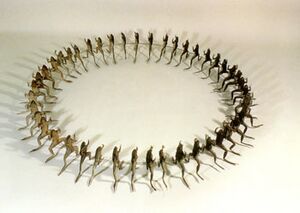María Fernanda Cardoso facts for kids
Quick facts for kids
María Fernanda Cardoso
|
|
|---|---|

Cardoso's portrait by photographer Ross Rudesch Harley
|
|
| Born | February 2, 1963 Bogotá, Colombia
|
| Education |
|
| Known for | Painting, Sculpture, Video art, Photography, Contemporary art |
|
Notable work
|
Cardoso Flea Circus, The Art of Disappearance, Preserved animals, Woven Water, Cemeteries, Corn |
| Spouse(s) | Ross Rudesch Harley |
María Fernanda Cardoso (born in 1963) is a talented artist from Colombia who now lives in Australia. She creates amazing contemporary art using all sorts of everyday materials. These include plastic, plants, dried animals, bones, and even styrofoam. One of her most famous art installations was a real flea circus! Her work has been shown in many museums around the world and has won several awards. She lives in Sydney, Australia.
Contents
About María Fernanda Cardoso
María Fernanda Cardoso was born in Bogotá, Colombia, in 1963. She started studying art and architecture in Bogotá in the early 1980s. Later, in 1990, she earned a special degree in Sculpture and Installation from Yale University in the United States.
In 1997, Cardoso moved to Sydney, Australia. She continued to create unique art pieces. In 2000, the famous Museum of Modern Art (MoMA) in New York asked her to make a big art installation. For this, she used 36,000 plastic lilies to create a long wall, which then traveled to other museums.
In 2003, she represented Colombia at the Venice Biennale, a big art show. There, she showed a large piece called "Woven Water." It was made from starfish woven together to look like an underwater scene. In 2012, she earned her PhD from the University of Sydney.
Her mother is the architect Eugenia Mantilla de Cardoso. Her sister is the film director Patricia Cardoso.
The Cardoso Flea Circus
One of María Fernanda Cardoso's most famous works is her flea circus. Yes, a real circus with tiny fleas as performers! She trained tiny cat fleas to do amazing tricks.
Flea Performers and Their Tricks
Cardoso's flea circus had many "performers" with special acts:
- Harry Fleadini: An escape artist who could get out of tiny spaces.
- Samson and Delilah: These strong fleas lifted small cotton ball weights.
- Teeny and Tiny: They were expert tightrope walkers.
- Pipita and Pepon: A flea couple who pushed glowing balls along a wire.
- Brutus: This powerful flea pulled a tiny locomotive.
How Fleas Were Trained
Cardoso trained the fleas using rewards. When a flea did what she wanted, she would let it feed directly on her blood. She explained that training fleas was very difficult and took six years. No one knew how to train fleas anymore, so she had to figure it out herself.
The first public show of the Cardoso Flea Circus happened in October 1996. It was at the Exploratorium in San Francisco. Because fleas are so small, she worked with Ross Rudesch Harley to add audio and video. This made the show bigger so everyone could see the tiny performers on a large screen. The famous Tate Modern art museum recently bought this unique art piece.
Other Creative Works
María Fernanda Cardoso has created many other interesting art pieces.
Cementerio—Vertical Garden
"Cementerio—Vertical Garden" is a series of unique art installations. These pieces use artificial flowers arranged as if they are growing horizontally from a wall. Pencil outlines of gravestones are drawn around them. Cardoso created these pieces from 1990 to 1999. They are now in major art collections around the world. These include the Museum of Modern Art (MoMA) in New York and the San Francisco Museum of Modern Art.
Dancing Frogs
"Dancing Frogs" is an art piece made from dried frogs. They are connected by a circular wire. The frogs look like they are spinning in circles, almost like they are doing a ritual dance. This artwork connects to the symbols of the Muisca people, an ancient group from Colombia. Circles and frogs were important symbols in their culture.


